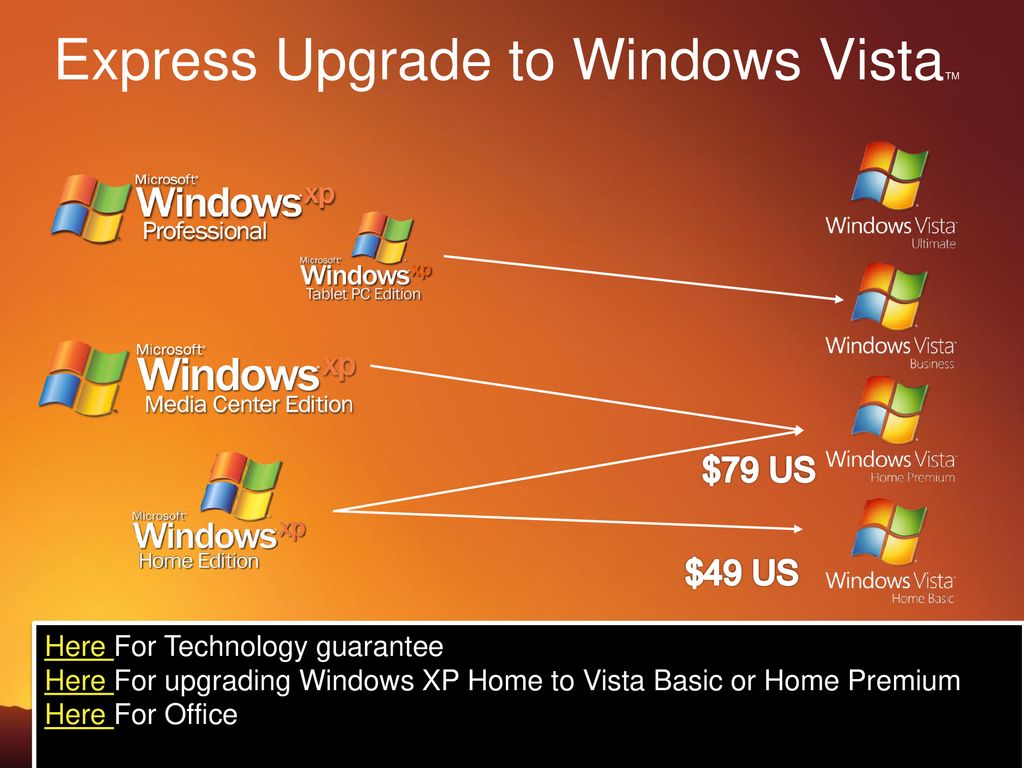

For this test, I used a combination of both upgrading via the physical DVD drive, and capturing an ISO, in order to get the feeling of what the actual process might be like, respectively to expedite non-essential aspects.
#XP HOME VISTA UPGRADE UPGRADE#
Using the actual DVD drive doesn’t even compare in terms of speed, but the experience, painfully slow, is closer to what end-users will run into in a real life upgrade scenario.
#XP HOME VISTA UPGRADE INSTALL#
For the upgrade, the operating system will copy the Windows 7 installation files, then gather files, settings and programs, then expand the files, install features and updates, and only then completes the upgrade (the part that will deal with migrating settings files and programs).įor Virtual PC 2007 VMs, the upgrading process literally flies when the capture ISO option is used and files are accessed from a Windows 7 Beta Build 7000 ISO on the hard disk.
#XP HOME VISTA UPGRADE SOFTWARE#
And the software giant is, by no means, kidding. Microsoft is, however, not delivering an estimate of the time remaining, and only saying that the process is bound to take several hours.

They will be able to see the volume of installation files that have already been copied along with the corresponding percentage out of the total number of items at any time. At least I had to, as I upgraded a Vista SP1 Ultimate copy to Windows 7 Beta Build 7000 Ultimate edition, both operating systems used as guests in a Virtual PC 2007 SP1 virtual machine running with 2GB of RAM.įor once, Microsoft provides the user with much more information when it comes down to the progress of the upgrading process. You will have to stare at the Upgrading Windows window for no less than an hour and a half and live through four reboots. The evolution from Vista to Windows 7 has also marked the evolution of the upgrading process. This because the upgrading process is completely automatic, following the initial steps that the end-user has to perform manually.Įssentially, upgrading to Windows 7 is a way to ensure that the operating system does all the heavy lifting, and, even if it is indeed a time-consuming process, stretching at least three or even four times as much as a clean install, the actual effort on behalf of the end-user is minimal. Microsoft reveals that the process allows users to “install Windows and retain applications, files, and settings as they were in previous edition of Windows.” And fact is that, in the context in which users have gathered a consistent volume of programs along with extensive customization, in-place upgrades make all the sense in the world, especially in scenarios in which re-installing all applications after a clean deployment of Windows would take in excess of a couple of hours. In-place upgrades are one of the installation options for Windows operating systems. Only Vista machines will be able to be upgraded in-place to Windows 7. They will need to perform a clean installation of Win 7 on top of XP. The bad news, as far as Windows XP users are concerned, is that Microsoft will not support in-place upgrades from XP to Windows 7.

The price is, of course, a critical factor when considering a jump to the next iteration of Windows, for both those that have coughed up a pretty dollar to upgrade to Vista, and also for the customers that have ridden XP for all its got, skipping the intermediary Windows 6.0 step. Still, the good news is that Microsoft will make available Windows 7 upgrade licenses for both Vista and XP. In fact, the software giant is making sure that the gap between the two operating systems is widened by the absence of in-place upgrade options. However, the same is not valid for Windows XP and Windows 7. In this context, the Redmond company has built a veritable bridge between Windows 6.0 (Vista) and Windows 6.1 (Win 7), when it comes down to in-place upgrades. Although in a delicate and continually evolving market share ballet, both Windows XP with 63.76% and Windows Vista with 22.48% (according to Net Applications) are equivalent to nothing short of a fair game for Windows 7.īecause, make no mistake about it, Windows 7 will grow its installed base for the most part to the detriment of its precursors. Just under a month ago, Microsoft made public its SKU (Stock Keeping Unit) strategy for Windows 7, while simultaneously delivering a sneak peek into the upgrade option details associated with the operating system.


 0 kommentar(er)
0 kommentar(er)
